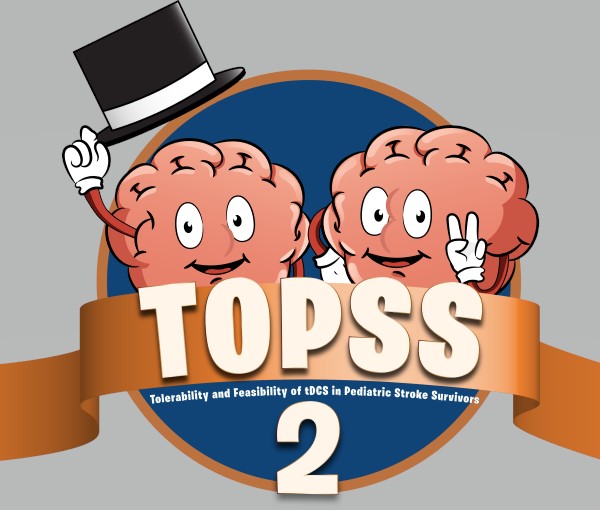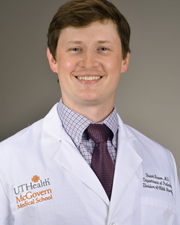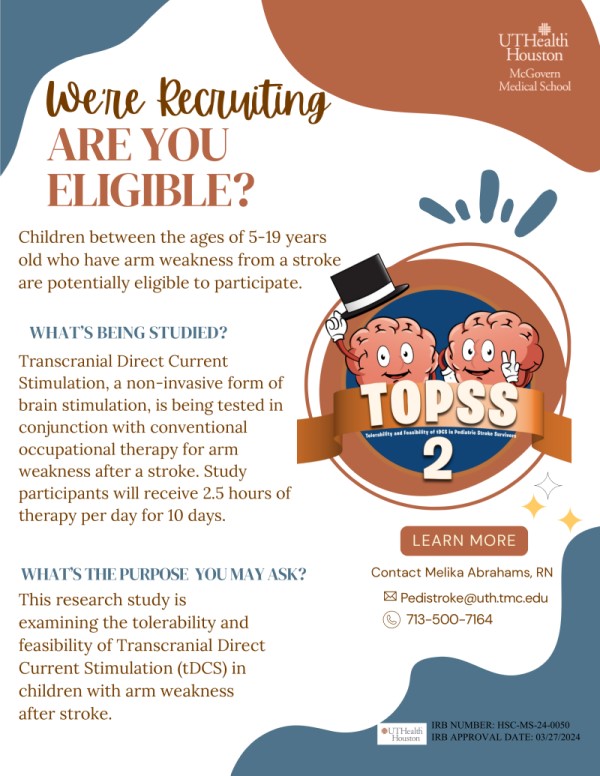TOlerabililty of Transcranial Direct Current Stimulation in Pediatric Stroke Survivors 2 (TOPSS 2)
Overview
 The TOPSS 2 study evaluates the safety, tolerability, and potential benefit of transcranial direct current stimulation (tDCS)—a non-invasive form of electrical brain stimulation—paired with intensive arm rehabilitation therapy in children and adolescents with chronic weakness after childhood-onset stroke. tDCS may help motor recovery by promoting neuroplasticity. This study aims to determine whether tDCS can safely be used in children, improve upper-extremity motor function, and inform design of future clinical trials.
The TOPSS 2 study evaluates the safety, tolerability, and potential benefit of transcranial direct current stimulation (tDCS)—a non-invasive form of electrical brain stimulation—paired with intensive arm rehabilitation therapy in children and adolescents with chronic weakness after childhood-onset stroke. tDCS may help motor recovery by promoting neuroplasticity. This study aims to determine whether tDCS can safely be used in children, improve upper-extremity motor function, and inform design of future clinical trials.
Participants are randomized to receive either active or sham (placebo) tDCS during a two-week rehabilitation period. After completing the blinded phase and follow-up, participants who initially received sham stimulation are invited to return for an open-label extension to receive active tDCS.
Population of the study: Children and adolescents aged 5 to 19 years with hemiparesis (arm weakness) following arterial ischemic or hemorrhagic childhood-onset stroke (≥3 months after the stroke event).
Intervention:
- Active tDCS: Bihemispheric stimulation using a 2 mA current applied via saline-soaked scalp electrodes for 20 minutes, immediately followed by 2 hours of one-on-one occupational therapy targeting the weaker arm.
- 10 total sessions over a 2-week period.
- tDCS parameters are individualized for comfort and safety, with continuous monitoring of vitals and tolerability.
Control: Participants randomized to sham stimulation receive identical therapy sessions with inactive current. All participants receive standard rehabilitation therapy under therapist supervision.
After 6-month follow-up, sham participants are offered open-label active tDCS using the same two-week therapy protocol.
Outcomes:
Primary (tolerability):
- Percentage of participants completing all stimulation sessions
- Percentage reporting only mild side effects (tingling, itching, or transient discomfort)
- Changes in vital signs (pulse and blood pressure) before and after stimulation
Secondary (exploratory efficacy:
- Change in Fugl-Meyer Upper Extremity (FM-UE) score from baseline to 6 months
- Secondary measures: Canadian Occupational Performance Measure (COPM), Box and Blocks Test, Pediatric Stroke Outcome Measure (PSOM), Melbourne Assessment of the Upper Extremity, and NIH Toolbox cognitive tests
- MRI-based measures of corticospinal connectivity (fractional anisotropy) and electric field modeling to explore predictors of response.
Trial Information
Target Enrollment: 20 participants
Funder: National Institutes of Health (NIH), National Institute of Neurological Disorders and Stroke (NINDS) — Child Neurologist Career Development Program (CNCDP K12)
Duration of Study: 3 years total (participant involvement up to 6 months; open-label extension available after follow-up)
Principal Investigator

Child & Adolescent Neurology
McGovern Medical School at UTHealth Houston
6410 Fannin, Suite 1535
Houston, TX 77030
(p): 713-500-7164
Research Team
- Research Nurse Melika Abrahams, RN, BSN
- Study Coordinator Antoinette Bernal-Tent, MPH
Links & Resources


